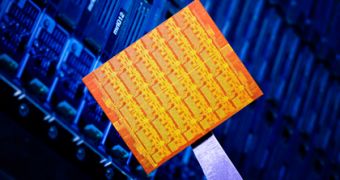The Larrabee might be dead but the technology that almost spawned it definitely isn't. This is what Intel confirmed today while at the International Supercomputing Conference in Hamburg, Germany. Though the GPU itself will never make it to market, the part can still be adapted for use in high-performance computing (HPC), much in the same way that NVIDIA Tesla Series modules have made their way into the Nebulae, now second greatest supercomputer in the TOP500 list.
The Santa Clara, California-based company has already made the first step towards putting this research to work. To be more specific, the chip maker revealed the name of its first commercially-available many-core processor series and has even put together some design and development kits.
Knights Corner is what the line of chips will be called. All models will have at least 50 cores per die and will be based on the 22nm manufacturing process technology, which means that their transistor structures are as small as 22 billionths of a meter.
In addition to this, the company has prepared a number of “Knights Ferry” development kits, which will give select developers some insight into the Intel MIC architecture, derived from Larrabee and other projects, such as Single-chip Cloud Computer (48-core supercomputer chip).
“Intel’s Xeon processors, and now our new Intel Many Integrated Core architecture products, will further push the boundaries of science and discovery as Intel accelerates solutions to some of humanity’s most challenging problems,” said Kirk Skaugen, vice president and general manager of Intel’s Data Center Group. “The Intel MIC architecture will extend Intel’s leading HPC products and solutions that are already in nearly 82 percent of the world’s top supercomputers. Today’s investments are indicative of Intel’s growing commitment to the global HPC community.”
“The CERN openlab team was able to migrate a complex C++ parallel benchmark to the Intel MIC software development platform in just a few days,” said Sverre Jarp, CTO of CERN openlab. "The familiar hardware programming model allowed us to get the software running much faster than expected.”

 14 DAY TRIAL //
14 DAY TRIAL //